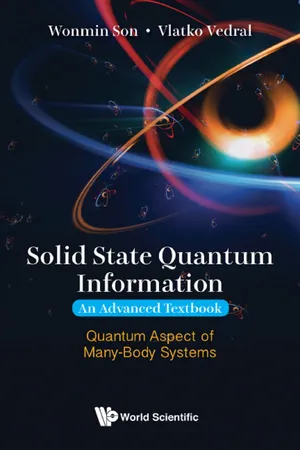![]()
Chapter 1
Introduction
Solid-state physics, the largest branch of condensed matter physics, is the study of rigid matter through scientific methods such as crystallography, metallurgy, electromagnetism and quantum mechanics. Solid-state physics considers how the large-scale properties of solid materials result from their atomic-scale properties. Thus, the solid-state physics is the theoretical basis of material science, and it has direct application in the various fields, for example, the technologies for transistors and semiconductors. To understand all those, it is crucial to use quantum mechanics and, in particular, quantum statistics. At first, we discuss basic methods to investigate the structure of a solid in this chapter. At the same time, the basic axioms of quantum theory as well as statistical mechanics will be briefly mentioned here.
1.1.Basic Structures of Solid
The solid materials are formed by densely packed atoms whose electrical, magnetic and thermal properties are determined by the way that they are arranged. We present the way to study the physical properties of solids. Atomic structure of solid is important factor which determines its large-scale properties. For example, spatial dimensionality of the solid determines the structure of its physical behavior.
A possible method to investigate the structure of a crystal is made through the X-ray beam which is scattered from solids. The basic idea was firstly proposed by German physicist von Laue in 1912. By looking at the intensity pattern of scattered X-ray, the structure of the solid can be revived. The logic is that if plane wave is incident to atoms in an array, then the atoms act as a multiple slit and create diffraction grating patterns as shown in Fig. 1.1.
Fig. 1.1. Lattice Interference: The plane wave incident to the atoms in an array creates the diffraction patterns.
Due to the difference of the path length, the electromagnetic wave interferes each other. The wave function ψ of the field at the vertical position x varies
Therefore, the intensity of the field becomes
The profiled intensity tells us about the probability amplitude coincide with the periodicity of the grating. Following the von Laue’s intuition [1], the same should work for any solids.
Typical spacing between atoms in a solid is 1−10 Å. Therefore, to inspect the structure of a solid using scattering techniques, one needs a probe beam with wavelength λ ≤ 10−9 m. The order of wavelength of X-rays is 10−10−2 nm, that of neutrons is 1−10 Å and that of electrons is 10−2 pm.
In a real situation, the lattice of a solid is layered in the two-dimensional (2D) space so that the interference pattern of scattered field is more complicated than the idealized one above. Bragg diffraction occurs when the wavelength λ of electromagnetic radiation incident upon a crystalline sample is comparable to atomic spacings. For a crystalline solid, the radiation is scattered in a specular fashion by the atoms in the system and the wave undergo constructive interference in accordance to Bragg’s law. When the waves are scattered from lattice planes separated by the distance d, the scattered waves interfere constructively when they remain in phase if the path length of each wave is equal to an integer multiple of the wavelength. The condition for the path difference between two waves undergoing constructive interference is given by
where θ is the scattering angle and n is integer. The formula state Bragg’s law which describes the condition for constructive interference from successive crystallographic planes of the crystalline lattice.
The 3D lattice plane can be described by three integer numbers called Miller indices (
h,
k,
l).
a Miller indices are a notation system in crystallography for the solid planes and its directions in crystal lattices. Each index denotes a plane orthogonal to a direction (
h,
k,
l) in the basis of the reciprocal lattice vector
. Due to the momentum conservation, the reciprocal lattice vector is obtained through the difference between the incoming and outgoing wave vectors,
where
are the vector components of the lattice. It also can be used to derive Bragg law (1.3) as it represents the lattice space. The space distance
d between the lattice planes can be related with the Miller indices
where a is the atomic lattice spacing of cubic crystal. Combining the relation with the Bragg scattering condition,
would give the selection rule of scattering beam for different crystals. Thus for all sets of Miller indices there is an angle that will satisfy the Bragg condition such that the value of
is a constant.
The important usage of the structural constants is to give the distinction between the crystal structures. The structures are identified by the different ways of stacking basic constituent, atoms in this case. In the ideal case, possible structures are the simple cubic (SC), the body-centered cubic (BCC) and the face-centered cubic (FCC) crystal structures as they are illustrated in Fig. 1.2. The discrimination can be made through the comparison between the allowed Miller indices and the properties can actually be evaluated from the analysis of the X-ray spectrum.
Let us discuss the physical conditions when the X-ray scattering occurs. If X-ray is triggered to the target crystal, the beam is refl...










